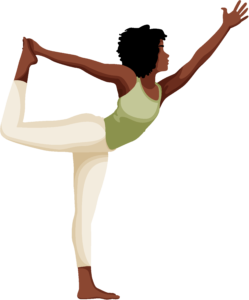Dancer’s (Natarajasana)
Pose Overview
| Common Name | Dancer's |
| Traditional Sanskrit Name | Natarajasana |
| Sanskrit Name Pronunciation | nah-tah-rah-JAH-sah-nah |
| Pose Difficulty | Intermediate |
| Drishti
Drishti is the gaze or visual focus point during yoga poses.
Learn more about Drishti |
Straight ahead or the nose |
Dancer's Pose, also known as Natarajasana, is a beautiful and challenging pose that is said to represent the cosmic dancer, Lord Shiva. This pose requires a great deal of balance, strength, and flexibility, making it a popular choice for intermediate and advanced yogis.
Benefits of Dancer's
Dancer's Pose is known to help improve balance and stability, increase flexibility in the legs, hips, and shoulders, and strengthen the muscles in the legs and core. It can also help to open the chest and improve posture.
How to Enter Dancer's
Begin by standing in Mountain Pose (Tadasana). Shift your weight onto your left foot and bend your right knee, bringing your right foot up towards your right glute. Take hold of your right ankle with your right hand, and extend your left arm out in front of you. Keep your chest lifted and your gaze forward as you kick your right leg back behind you.
How to Exit Dancer's
Release your ankle and lower your right foot to the ground, returning to Tadasana.
Common Dancer's Modifications & Variations
If you're having trouble balancing, try placing your hand on a wall or chair for support. You can also work on building strength in your legs and core before attempting this pose.
Common Mistakes with Dancer's
It is important to keep your chest lifted and your gaze forward during the pose. Also, make sure to keep your standing leg strong and engaged to prevent any strain in the knee.
Safety Guidance
Be careful not to overstretch your hamstring or put too much pressure on your standing knee. It is best to practice under the guidance of a qualified yoga instructor.

